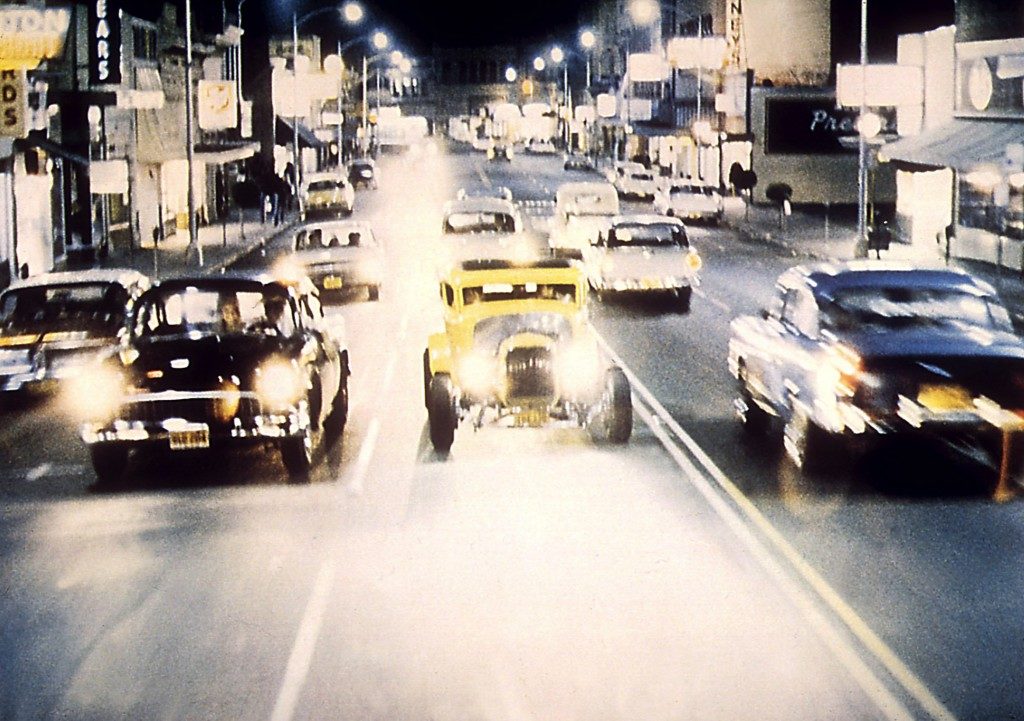Wine Country’s quaint hamlets and seaside towns have attracted Hollywood hot shots including Alfred Hitchcock, George Lucas and Francis Ford Coppola.
Visitors to Sonoma might think they’ve seen it all before, and they probably have: in films featuring its quaint towns, dramatic coastline, ancient redwood stands, rolling hills and valleys. Hitchcock, Lucas and Coppola were so seduced by Sonoma’s small-town America charm that they filmed entire movies here, in effect advertising the region to the world.
For more than 100 years, the local landscape has starred in dozens of movies and television commercials, providing the background eye candy for everything from classic coming-of-age movies to breezy car commercials to President Ronald’s Reagan’s famous “Morning in America” TV re-election campaign spot, filmed largely in Petaluma, in 1984.
“The scenery of Sonoma is wonderful and it’s also very adaptable,” said Colette Thomas, film liaison for the Sonoma County Economic Development Board. “We have winding roads, rolling hills, fantastic beaches. It can be used as anything from a plaza in Mexico to an olive grove in Italy.”
It’s not unusual to see a film crew somewhere around Sonoma. In 2014, the county issued 85 permits for 105 days of filming, including a multiday courtroom shoot at city hall in Petaluma for “The Wrong Side of Right,” a feature about an animal rights activist who goes undercover at a dog-breeding facility.
More recently, the county starred in “For What It’s Worth,” with James Franco and Sharon Stone. Scenes from the upcoming picture were shot in Geyserville, Sebastopol, Guerneville and Monte Rio, causing a buzz in those small communities — literally. Soon after arriving in the area, Franco took a walk through Armstrong Redwoods State Natural Reserve near Guerneville.
While there, he posted a selfie to Instagram with the caption: “Nor Cal. Smell the weeeeeed.”
Some of the earliest U.S. cinematic films were made here, including the 1914 production of “Salomy Jane,” a wild soap opera about California pioneers that was based on the Bret Harte novella of the same name. The California Motion Picture Corp. produced this tale of love, murder and mistaken identity, complete with a doe-eyed heroine, an unscrupulous ruffian and a heroic stranger. Filming took place in the hills near San Rafael in Marin County; the Russian River towns of Guerneville and Monte Rio in Sonoma were used for a final chase. The sharp-eyed will also notice the handsome silhouette of Marin’s Mount Tamalpais behind the love-happy couple in the film’s closing shot. The movie was a hit, packing theaters in San Francisco and Oakland. Moving Picture World, one of the leading journals of the budding film industry, praised its “exceptionally fine photography” and “the love story that becomes more and more interesting toward the close.”
It was also the beginning of a love story between the motion picture industry and Sonoma. Its cities and landscapes have shown up everywhere on screen. One can see the Village Inn Lodge in Monte Rio bedecked with fake snow for “Holiday Inn,” the 1942 movie that introduced Bing Crosby’s classic rendition of the song “White Christmas.” The tiny Cloverdale Airport appears in Mike Myer’s hilarious “So I Married an Axe Murderer.” Downtown Santa Rosa is the setting for Alfred Hitchcock’s thriller, “A Shadow of a Doubt.”
The most popular filming locale in Sonoma, however, is Petaluma, and it’s easy to see why. It has a beautiful and well-preserved city center that’s on the National Register of Historic Places, and was one of the few local communities left standing after the devastating 1906 earthquake.
Petaluma was featured in a range of movies, from the Oscar-winning 1947 film “The Farmer’s Daughter” to Cary Grant’s 1948 “Mr. Blandings Builds His Dream House” (where it played the role of rural Connecticut) to “Cujo,” about a killer dog. It also featured prominently in Francis Ford Coppola’s “Peggy Sue Got Married” and Paul Verhoeven’s “Basic Instinct,” the latter of which starred Sharon Stone and her legs. Filmmakers particularly love the downtown area around Western Avenue and Petaluma Boulevard, with McNear’s Mystic Theatre and Saloon as a popular backdrop.
The most celebrated movie filmed in Petaluma, though, is 1973’s “American Graffiti,” which practically used the city as a co-star. “American Graffiti,” which came out two years before “Star Wars,” was the movie that put its 28-year-old director, George Lucas, on the map. It’s set in 1962, and is a wonderful comedic drama about the cruising and rock ’n’ roll culture among teens in small towns.
“There is a uniquely American mating ritual involving automobiles,” said Lucas, who was auto-obsessed. “When I was young, cars were my life. That’s what I thought I was going to do — be a mechanic and race cars.”
The film, starring Richard Dreyfuss, Ron Howard, Harrison Ford, Paul Le Mat, Bo Hopkins, Cindy Williams, Candy Clark and Charles Martin Smith, was inspired by Lucas’ adolescence in the Central Valley town of Modesto.
The first choice for filming was San Rafael, which was near Lucas’ Marin home as well as Skywalker Ranch, the center of his newly launched Lucasfilm. Production started in early summer 1972 and immediately hit a wall. It took longer to fix camera mounts on the car than Lucas had hoped, delaying some work. A member of the production team was busted for growing marijuana, according to Dale Pollock’s book, “Skywalking: The Life and Films of George Lucas.” Then the San Rafael City Council, worried about disruption filming caused for local businesses, limited shooting to just two days.
Plans were made to move 20 miles north to Petaluma, which had a similar small-town feel, while Lucas quickly grabbed as many general San Rafael cruising shots on downtown Fourth Street as he could. (In the movie, they’re easily identified when all traffic moves in one direction; Petaluma scenes have two-way traffic).
Still, there were problems, according to John Baxter’s “Mythmaker: The Life and Work of George Lucas.” Le Mat, Ford and Hopkins often drank heavily between takes and would climb to the top of a Holiday Inn sign. Ford was arrested in a bar fight. Lucas’ motel room was accidentally set on fire.
Despite the trouble, “American Graffiti” wrapped in early August and was released a year later. It was an immediate smash, pulling in $144 million against just $777,000 in production costs. It also spawned a wave of imitating films and TV shows, among them “Happy Days” and “Laverne & Shirley.”
“American Graffiti” earned an Oscar nomination for Best Picture (it lost to “The Sting”). Lucas was also nominated for best writer (losing to David S. Ward for “The Sting”) and director (beaten by George Roy Hill for, you guessed it. “The Sting”).
Today, passersby in downtown Petaluma can still recognize the usedcar lot where Curt (Dreyfuss) chained the axle of the police car. It’s a vacant lot alongside the McNear Building (15-23 Petaluma Blvd.). In the background is the “State Movie Theater” (actually the Mystic) with “Dementia 13” on the marquee – an inside nod to Coppola, who directed and wrote that 1963 thriller a decade before producing “American Graffiti.”
Equally famous Sonoma movie hot spots are the coastal towns of Bodega and Bodega Bay, best known as locations for Alfred Hitchcock’s classic 1963 horror film, “The Birds.” The movie was based on a short story by Daphne du Maurier, which was set in an English seashore village. But Hitchcock thought the foggy, treeless shores of western Sonoma would do just fine for the setting of his tale about murderous birds.
While several of the key filming sites, such as the Tides Wharf & Restaurant in Bodega Bay, have been changed almost beyond recognition, a few remain frozen in time. The pretty James E. Potter Elementary School in Bodega was vacant at the time of the filming, but the crew repaired the exterior and it was used for several scenes. Some say Hitchcock’s film saved the old place, built in 1873. It’s now a private residence.
If you’re looking for the monkey bars where the first gulls, ravens and crows gathered around Melanie Daniels (Tippi Hedren) and the next-door home of school teacher Annie Hayworth (Suzanne Pleshette), they’re no longer there. Nearby, however, is the steepled, white wooden St. Teresa of Avila Catholic church. It’s briefly glimpsed in the film, but received more recognition when Ansel Adams photographed it.
Many of the roads and vistas in the area remain the same. For a fun afternoon, the Sonoma Coast Visitor’s Center (Highway 1, Bodega Bay) offers a map to the film various site. Just don’t look funny at those feathered friends up in the trees. They may get ideas.
Hitchcock was said to be more proud of “Shadow of a Doubt,” shot in Santa Rosa in 1942, than he was of “The Birds.” As historian Gaye LeBaron reported in 2009 in The Press Democrat, Hitchcock brought filming of “Shadow” to Santa Rosa because it was wartime and there was a $5,000 limit for spending on Hollywood movie sets.
“Hitchcock’s decision, made along with producer Jack Skirball, to find a town that fit the script and move in, was considered important enough that LIFE magazine sent three photographers and published a six-page spread on Hitch’s Santa Rosa adventure,” LeBaron wrote, noting that Visalia in the Central Valley was the other location finalist. “The whole town, population 13,000, became a Universal studio for four weeks in the summer of 1942.
“They didn’t have to change a thing, except to put a coat of oil on the Victorian at 904 McDonald Ave. they had chosen to be the family home. The owner, Dr. Clifford Carlson, had been so pleased when his house was selected, he’d spruced it up with a new coat of white paint between the Hitchcock-(novelist Thornton) Wilder visit and the arrival of the actors. It looked too new, Hitchcock said, and ordered it oiled.”
While film permit fees still bring a tidy sum to Sonoma County — $1.93 million in 2014, a nearly 14 percent increase from 2013 — the region is seeing fewer feature films being made here, although commercials (particularly for automobiles) and still photo shoots remain popular.
“There is so much they can do in their studios with special effects that some crews no longer need to go on location,” said Ben Stone, executive director of the county’s Economic Development Board, which runs the Sonoma County Film O’ce. Interestingly, two of the major perpetrators of that digital movement live nearby: Lucas in Marin, and John Lasseter (Pixar Animation Studios, Walt Disney Animation Studios) in Sonoma.
Still, Stone and his team try to tempt the Tinseltown moguls to come north for future films. The website for the Sonoma County film office offers nugget descriptions of hundreds of locations, ranging from Cougar Mountain Drive near Sears Point (“Two-way paved road winding through sprawling green pastures and land”) to Santa Rosa High School (“Arched entryways and traditional European design in front.”) to Kunde Family Winery (“Overlooks sprawling vineyards and Sonoma County hillsides.”) For now, they’ll take what business they can get. But it’s an uphill battle and, recently, there have been fewer takers.
In the meantime, movie lovers can enjoy the Sonoma International Film Festival, a five-day event that lights up the area with great cinema, food and celebrities each spring (March 30 through April 3 this year). Or save the cost of a movie ticket and just step out the door to take a stroll. Sonoma is always lovely and cinematic, whether a crew is filming here or not.










